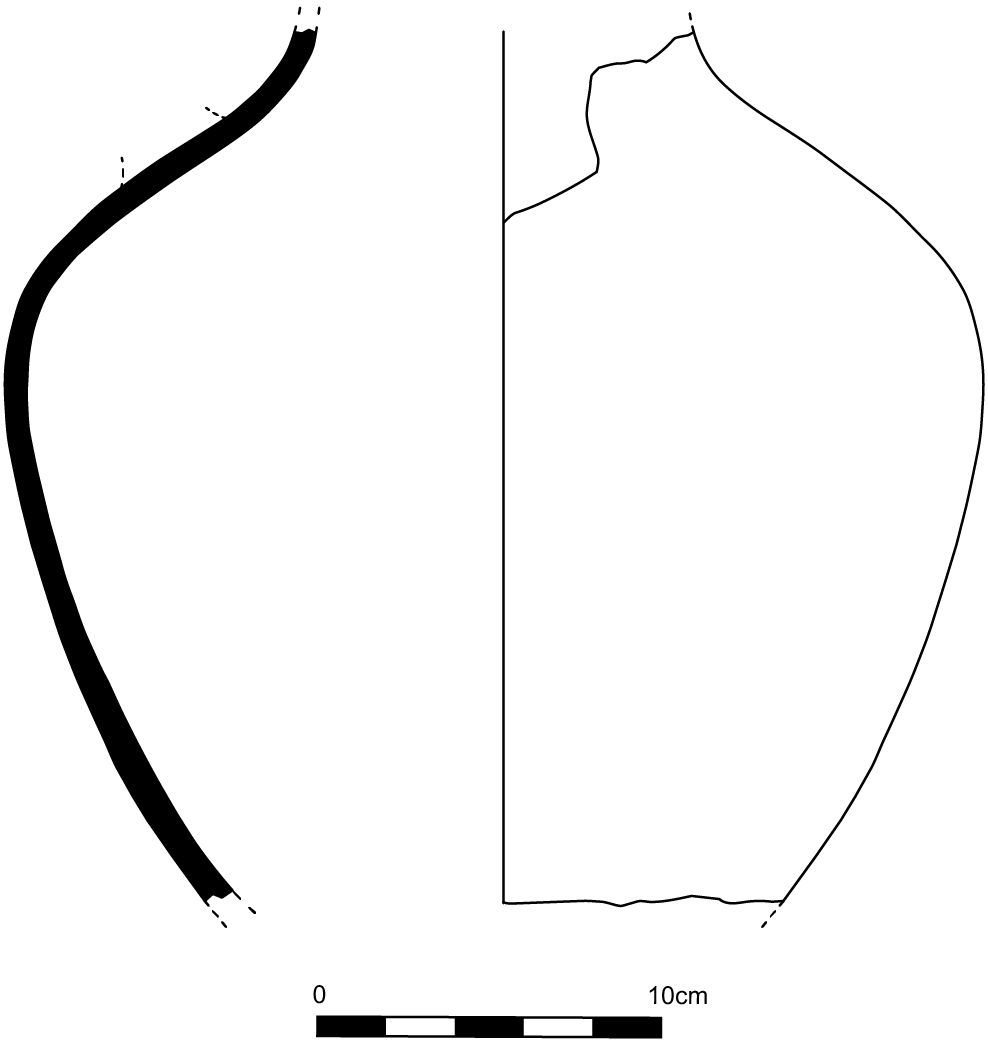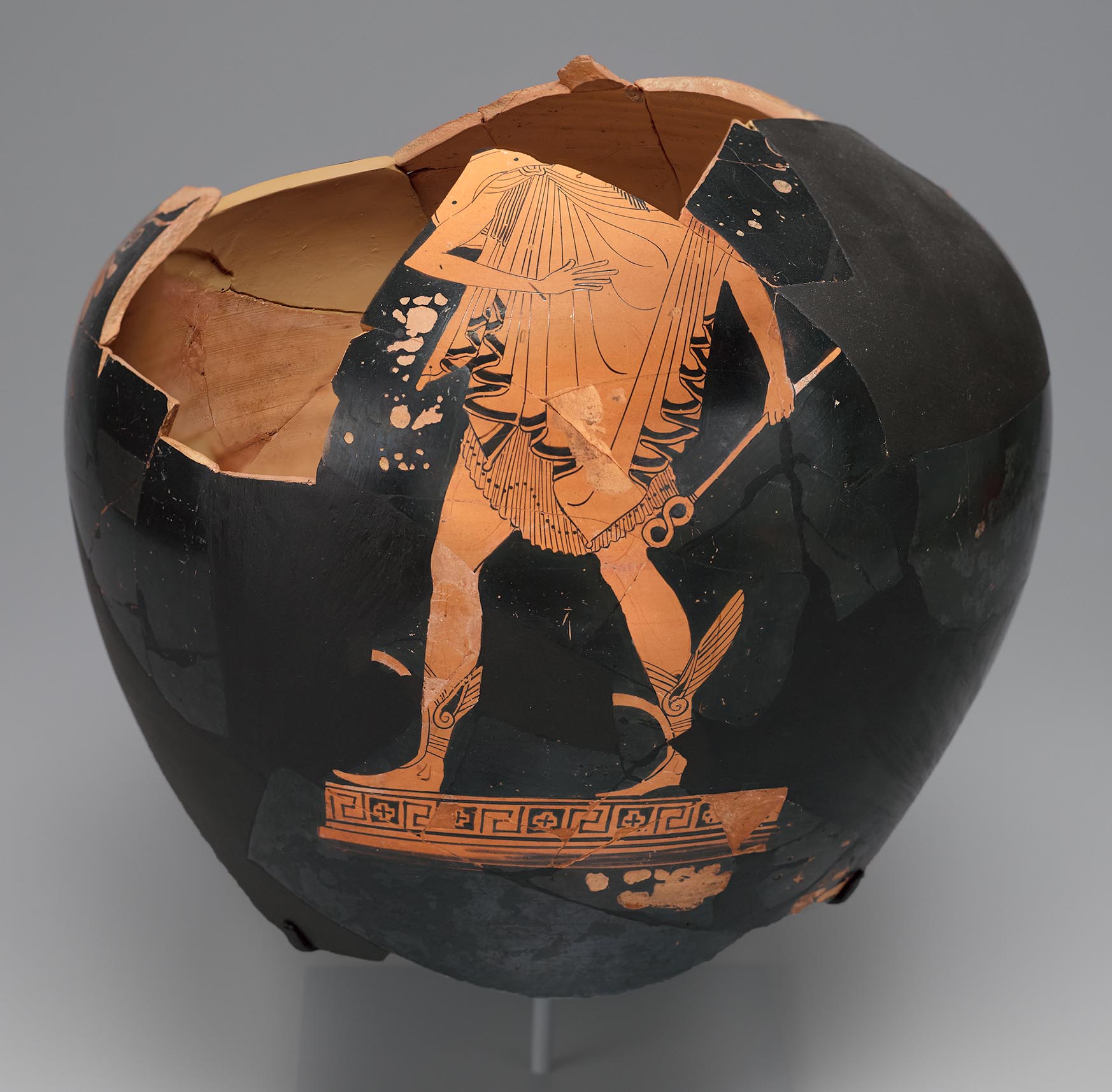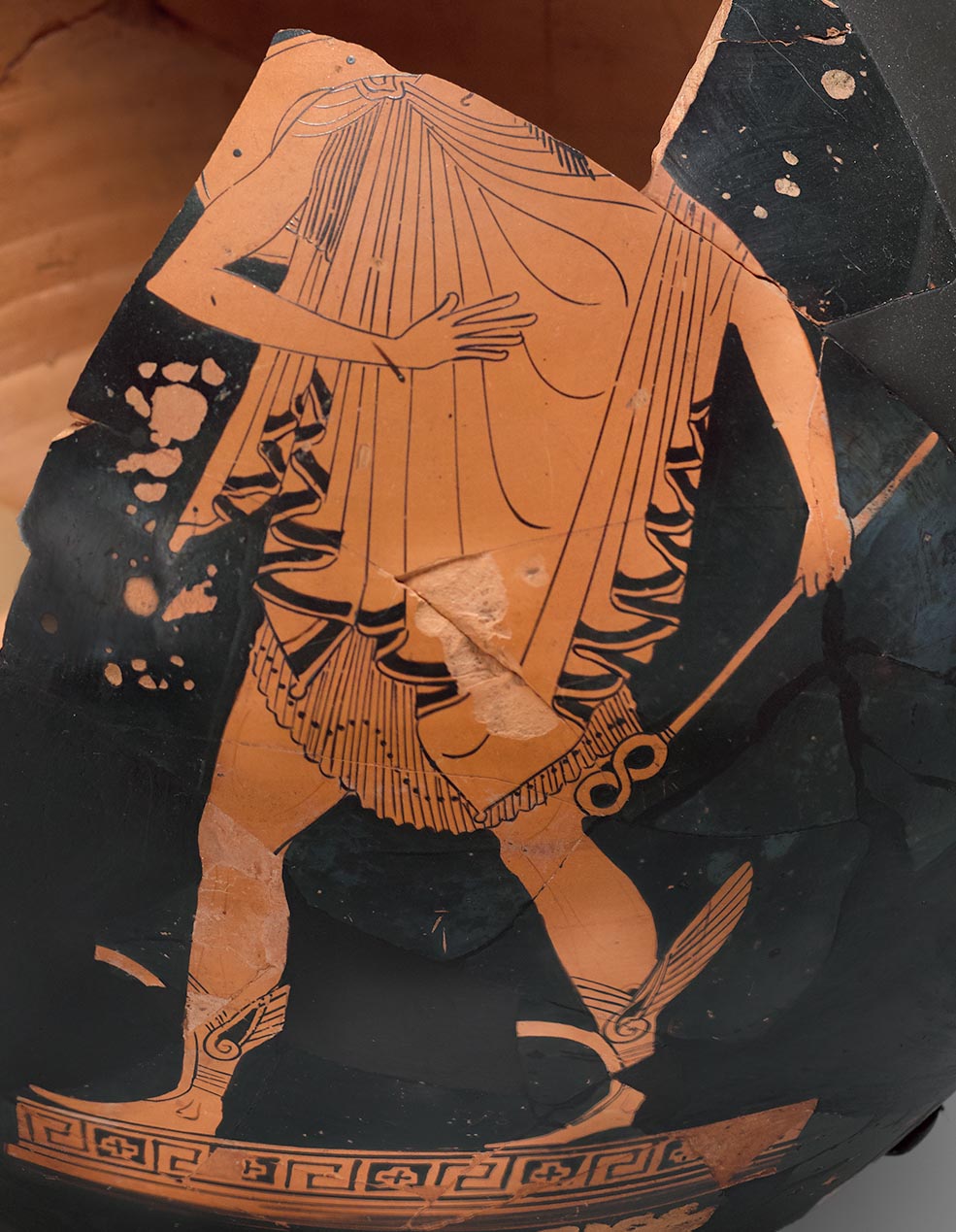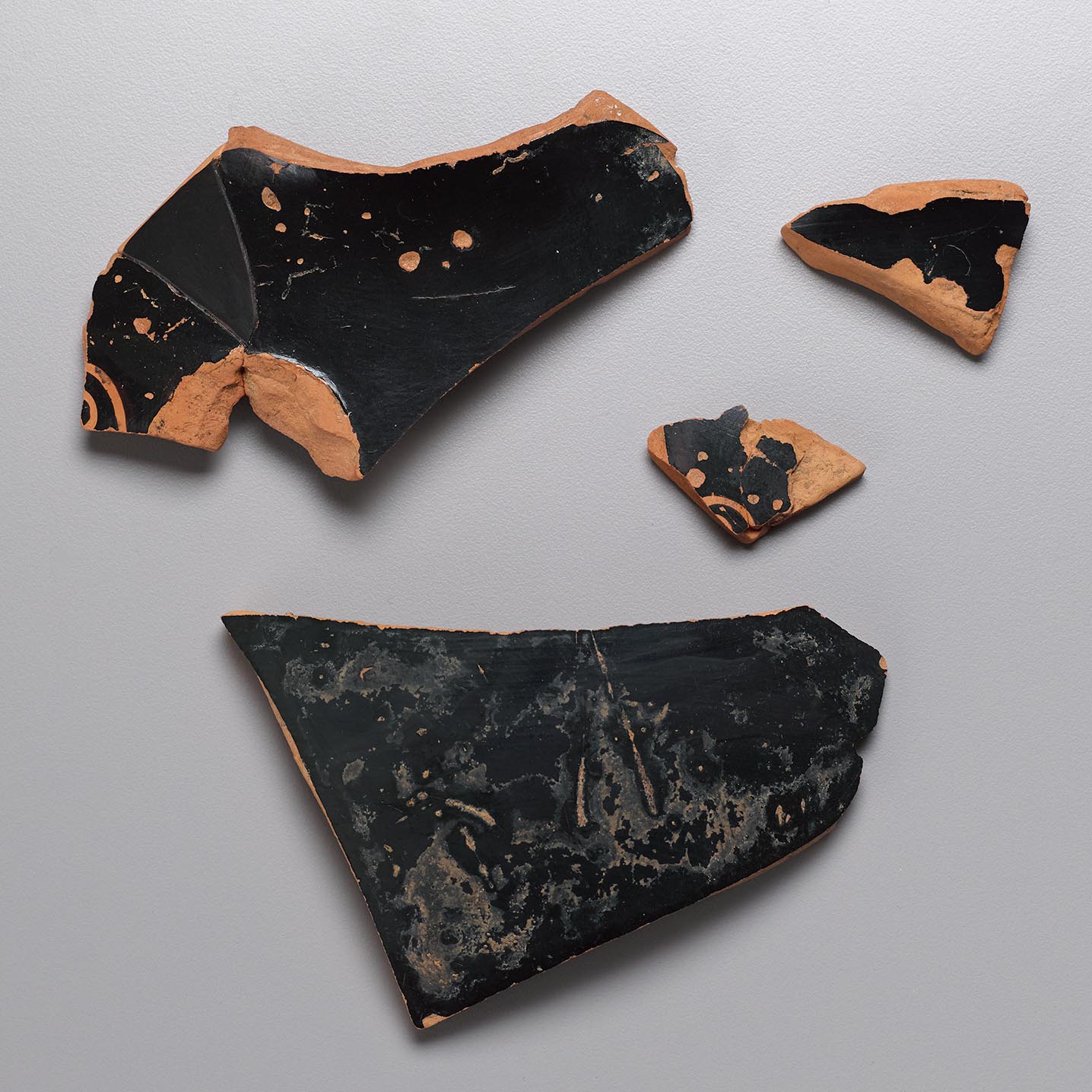Provenance
1988, sale, Galerie Nefer (Zürich) to Princeton University.
Shape and Ornament
Nonjoining fragment (Fragment c) from the lower portion of narrow neck. Principal fragment (Fragment a) from sharply tapering body. Pendant palmettes beneath each of the now-lost handles; thirteen fronds and core with black center. Coiling tendrils extend obliquely upward from either side of the bottom of the palmettes; portion of tendril preserved on nonjoining neck fragment (Fragment c). On both sides, groundline of dotted cross squares alternating with stopt keys facing right; framed by reserved stripes. On side B, wider reserved stripe below and contiguous with ornamental band, extending beyond it at the left; at the right, painted streaky black.

Subject
A. Herakles. The hero, spotlit against the black ground, walks barefoot to the right, his body and head in profile. He holds a kantharos in his right hand and a barbitos in his left. No strap supports the instrument, which he presses against his left hip while fingering the strings. He throws his head back as if he were about to break into song. He wears his distinctive, dappled lion skin, the forelegs tied across his chest. The unbelted skin flutters behind him like a cape, exposing his nude, rather lithe body. His head is encased in the lion’s scalp, replete with sharp teeth.
B. Hermes. The god walks in profile to the left, his legs wide apart. Although his head is not preserved, the fringe of his beard indicates that he is looking back to the right, perhaps acknowledging the presence of Herakles. A single lock of hair in dilute gloss is visible on his neck. He wears a finely pleated chitoniskos and, over this, pinned at the right shoulder, a short chlamys with a thick black hem that falls in fluid zigzag folds. A petasos with dots on the inside of the brim hangs behind his right shoulder. The god wears his distinctive shoes, with lolling tongues and stiff, carefully drawn wings, which spring from volutes. He holds his kerykeion (herald’s wand) in his left hand, the top of which is curiously closed (it is not repainted).
Attribution and Date
Attributed to the Pan Painter [J. R. Guy]. Circa 480–470 BCE.
Dimensions and Condition
Fragment a (principal restored piece): h. 22.9 cm; diam. 28.0 cm.
Fragment b (single large body fragment): 12.2 × 8.4 cm; thickness: max. 0.9 cm; min. 0.7 cm.
Fragment c (two joined fragments from the neck): 12.1 × 6.9 cm; thickness: at neck 0.9 cm; at shoulder 0.7 cm.
Fragment d (single small body fragment): 4.4 × 3.3 cm; thickness 0.9 cm.
Fragment e (single small body fragment): 4.1 × 2.6 cm; thickness 0.7 cm.
Several joining fragments are mended to form the principal fragment (Fragment a), with gaps restored in plaster and painted black. Four nonjoining fragments are also preserved. Mouth, foot, and handles are entirely missing. Handle roots form neat, circular declivities. The right lower calf and foot of Herakles are completely missing, as is the back of his left foot and heel. The top of the lion’s scalp on Herakles’s skin is missing, along with its eyes. Hermes’s head is completely missing, as are portions of his right leg and left foot, and the tips of his shoe tongues, the lengths of which are uncertain. A wide gash mars his lower chlamys. Many chips on the surfaces of the fragments, predominantly around the edges, with consequent loss of black gloss.
Technical Features
Preliminary sketch. Relief contour for arms, hands, and portions of the kerykeion. Accessory color. Dilute gloss: dappled textures of the lion skin; internal musculature.
Bibliography
Abbreviation: Princeton RecordRecord of the Princeton University Art Museum. (1942– ). 48 (1989): 53 [illus.]; H. A. Shapiro, “Fragmentary Red-Figure Amphora of Panathenaic Shape,” in Abbreviation: Padgett, Berlin PainterJ. M. Padgett, with contributions by N. T. Arrington et al. The Berlin Painter and His World: Athenian Vase-Painting in the Early Fifth Century B.C. Princeton, 2017, 240–41, no. 14; Abbreviation: BAPDBeazley Archive Pottery Database. http://www.beazley.ox.ac.uk 41237.
Comparanda
For the Pan Painter, see Abbreviation: ARV2J. D. Beazley. Attic Red-Figure Vase-Painters. 2nd ed. Oxford, 1963 550–61, 1658–59; Abbreviation: ParalipomenaJ. D. Beazley. Paralipomena: Additions to Attic Black-Figure Vase-Painters and to Attic Red-Figure Vase-Painters. Oxford, 1971 386–88, 513; Abbreviation: BAdd2Carpenter, T. H., ed. 1989. Beazley Addenda: Additional References to ABV, ARV2, and Paralipomena. 2nd ed. Oxford: Published for the British Academy by Oxford University Press. 256; J. D. Beazley, “The Master of the Boston Pan-Krater,” Abbreviation: JHSJournal of Hellenic Studies 32 (1912): 354–69; id., The Pan Painter (Mainz, 1974); A. B. Follmann, Der Pan-Maler (Bonn, 1968); L. Byvanck-Quarles van Ufford, “Le psykter de Marpessa à Munich: Vase de style archaïque ou vase de style archaïsant?,” Abbreviation: BABeschBulletin antieke beschaving. Annual Papers on Classical Archaeology 44 (1969): 124–35; C. Sourvinou-Inwood, “Who Was the Teacher of the Pan Painter?,” Abbreviation: JHSJournal of Hellenic Studies 95 (1975): 107–21; M. Robertson, “Two Pelikai by the Pan Painter,” in Abbreviation: GkVasesGetty 3Frel, J., and M. True, eds. 1986. Greek Vases in the J. Paul Getty Museum. Vol. 3. Occasional Papers on Antiquities 2. Malibu: J. Paul Getty Museum., 71–90; Abbreviation: Robertson, Art of Vase-PaintingM. Robertson, The Art of Vase-Painting in Classical Athens. Cambridge, 1992, 143–52; A. C. Smith, “The Evolution of the Pan Painter’s Artistic Style,” Abbreviation: HesperiaHesperia: The Journal of the American School of Classical Studies at Athens 75 (2006): 435–51. In his initial publication on the Pan Painter, Beazley noted a “strong and peculiar stylization, a deliberate archaism, retaining old forms but refining, refreshing and galvanizing them” (Beazley, “Boston Pan-Krater,” 354), characteristics that later formed the basis for the Mannerist Workshop. Beazley thus believed the Pan Painter’s teacher to have been Myson, in whose workshop the Earlier Mannerists learned their trade. There are elements of kinship between the Princeton vase and the only amphora of Panathenaic shape that has been attributed to Myson: Florence 3982 and Paris, Louvre Cp 12160 (Abbreviation: ARV2J. D. Beazley. Attic Red-Figure Vase-Painters. 2nd ed. Oxford, 1963 238.2; Abbreviation: BAPDBeazley Archive Pottery Database. http://www.beazley.ox.ac.uk 202177), cf. the key pattern of the groundlines, and the cloak and extravagant shoes of Apollo. These similarites alone do not evince contemporaneity but support an early date for the Princeton amphora. Other passages also recall Myson: e.g., the dotted tail of the lion skin, the thick tip of which is textured the same as the rest of the tail, is like that on Myson’s pelike: Munich NI 8762 (Abbreviation: ARV2J. D. Beazley. Attic Red-Figure Vase-Painters. 2nd ed. Oxford, 1963 1638.2 bis; Abbreviation: BAPDBeazley Archive Pottery Database. http://www.beazley.ox.ac.uk 275132). The drawing of the hero’s face is quite different, however, recalling instead the Pan Painter’s famous Busiris pelike: Athens 9683 (Abbreviation: ARV2J. D. Beazley. Attic Red-Figure Vase-Painters. 2nd ed. Oxford, 1963 554.82; Abbreviation: BAPDBeazley Archive Pottery Database. http://www.beazley.ox.ac.uk 206325). The Pan Painter’s noses are short and flat, and his heads small. Herakles’s beard in Princeton and Athens is short, emphasizing the rounded chin typical of the Pan Painter. In addition, the lion skin on Princeton’s amphora and on the Busiris pelike is left unbelted, secured only by means of similarly executed forepaws, a distinctive approach that reveals the hero’s nude torso. For another example by the Pan Painter, cf. Berlin F 4027 (Abbreviation: ARV2J. D. Beazley. Attic Red-Figure Vase-Painters. 2nd ed. Oxford, 1963 551.5; Abbreviation: BAPDBeazley Archive Pottery Database. http://www.beazley.ox.ac.uk 206280). Subsequent studies questioned the relationship between the Pan Painter and Myson, with both Follmann (Der Pan-Maler, 70–72) and Robertson (Abbreviation: Robertson, Art of Vase-PaintingM. Robertson, The Art of Vase-Painting in Classical Athens. Cambridge, 1992, 143) concluding that although the Pan Painter learned something from Myson, there was no direct workshop apprenticeship.
For the suggestion that the Pan Painter’s master was the Berlin Painter, see Sourvinou-Inwood, “Who Was the Teacher”; Smith, “Evolution.” Robertson (Abbreviation: Robertson, Art of Vase-PaintingM. Robertson, The Art of Vase-Painting in Classical Athens. Cambridge, 1992, 146), in contrast, doubts that the Pan Painter was ever an apprentice to the Berlin Painter, while still noting the Berlin Painter’s influence on the younger artist, in particular in his liking for lekythoi. As noted by Beazley (Pan Painter, 9) and Sourvinou-Inwood (“Who Was the Teacher,” 111–12), the Pan Painter took an interest in a swift and contrasting contour at a time when mass and volume drew the attention of other vase-painters. On Princeton’s amphora, the arms, objects, and tilted head radiating from Herakles’s body form an arc in the upper half of the composition and enliven the solitary figure. This emphasis on motion and contour brings such works closer to the Berlin Painter. Less in detail than in spirit, one is reminded of the Berlin Painter’s earlier isolation of a similarly appareled Hermes on an amphora of Panathenaic shape in Rome: Vatican 17907 (Abbreviation: ARV2J. D. Beazley. Attic Red-Figure Vase-Painters. 2nd ed. Oxford, 1963 197.5; Abbreviation: BAPDBeazley Archive Pottery Database. http://www.beazley.ox.ac.uk 201813). For the pinwheeling pose of the Princeton Hermes, the closest comparison is his counterpart on another early work, the Pan Painter’s Marpessa psykter: Munich SH 2417 (Abbreviation: ARV2J. D. Beazley. Attic Red-Figure Vase-Painters. 2nd ed. Oxford, 1963 556.101; Abbreviation: BAPDBeazley Archive Pottery Database. http://www.beazley.ox.ac.uk 206344). On the Marpessa psykter, the god’s shoes are “winged” only with over-long tongues, a common short-cut; cf. London E 181 (Abbreviation: ARV2J. D. Beazley. Attic Red-Figure Vase-Painters. 2nd ed. Oxford, 1963 555.96, 1659; Abbreviation: BAPDBeazley Archive Pottery Database. http://www.beazley.ox.ac.uk 206339), where the shoes are worn by Perseus. For the notably pointed elbows of the figures on the Princeton amphora, cf. Boreas on London E 512 (Abbreviation: ARV2J. D. Beazley. Attic Red-Figure Vase-Painters. 2nd ed. Oxford, 1963 557.125; Abbreviation: BAPDBeazley Archive Pottery Database. http://www.beazley.ox.ac.uk 206369); and Hermes on Munich SH 2417 (supra).
On the Princeton vase it is possible to make out the dilute gloss contours of Herakles’s rectus abdominis, which preserves three bulges, or half of the six bulges that would be visible if seen frontally. This is highly uncommon in the work of the Pan Painter, who, like Myson, prefers drawing only four bulges with two vertical divisions. Beazley (“Boston Pan-Krater,” 364) went so far as to say that this was the Pan Painter’s “invariable practice.” The three vertical divisions on Princeton’s amphora cannot be attributed simply to the profile stance of Herakles, as the profile of Pan on the painter’s name-vase in Boston only shows two divisions from the side: Boston 10.185 (Abbreviation: ARV2J. D. Beazley. Attic Red-Figure Vase-Painters. 2nd ed. Oxford, 1963 550.1, 1659; Abbreviation: BAPDBeazley Archive Pottery Database. http://www.beazley.ox.ac.uk 206276). As the six-bulge rectus abdominis is the scheme favored by the Berlin Painter, its appearance here perhaps evinces a further connection between the two artists, though the Berlin Painter was hardly the only artist to prefer it.
For red-figure amphorae of Panathenaic shape, see J. D. Beazley, “The Master of the Stroganoff Nikoxenos Vase,” Abbreviation: BSABritish School at Athens Annual 19 (1912–13): 229–47; Abbreviation: AgoraAthenian Agora (Princeton 1953– ) 30, 9–11; M. Bentz and N. Eschbach, eds., Panathenaïka: Symposion zu den Panathenäischen Preisamphoren, Rauischholzhausen (Mainz, 2001); J. Neils, “Yet Another Red-Figure Panathenaic Amphora,” Abbreviation: MeditArchMediterranean Archaeology: Australian and New Zealand Journal for the Archaeology of the Mediterranean World 17 (2004): 61–64. For black-figure Panathenaics, see Abbreviation: ABVJ. D. Beazley. Attic Black-Figure Vase-Painters. Oxford, 1956 403–17, 696; Abbreviation: ParalipomenaJ. D. Beazley. Paralipomena: Additions to Attic Black-Figure Vase-Painters and to Attic Red-Figure Vase-Painters. Oxford, 1971 17–178; J. D. Beazley, The Development of Attic Black-Figure (Berkeley, 1986), 81–92; M. B. Moore, M. Z. P. Philippides, and D. von Bothmer, Attic Black-Figured Pottery, Abbreviation: AgoraAthenian Agora (Princeton 1953– ) 23 (Princeton, NJ, 1986), 12–17; M. Bentz, *Panathenäische Preisamphoren: Eine athensiche Vasengattung und ihre Funktion vom 6.–4. Jahrhundert v. Chr. * Abbreviation: AntK-BHAntike Kunst: Beiheft 18 (Basel, 1998). Although no painter specialized in the shape, the Berlin Painter decorated several Panathenaics, which spotlight unframed figures against the black ground, as on this amphora, an approach first seen in the Pioneer Workshop: see H. A. Shapiro, “The Berlin Painter’s Panathenaic Amphorae,” in Abbreviation: Padgett, Berlin PainterJ. M. Padgett, with contributions by N. T. Arrington et al. The Berlin Painter and His World: Athenian Vase-Painting in the Early Fifth Century B.C. Princeton, 2017, 132–43. On two occasions the Berlin Painter decorated the shape with a kitharode: Montpellier, Fabre 130 (Abbreviation: ARV2J. D. Beazley. Attic Red-Figure Vase-Painters. 2nd ed. Oxford, 1963 197.10; Abbreviation: BAPDBeazley Archive Pottery Database. http://www.beazley.ox.ac.uk 201818); and Paris, Louvre MNE 1005 (Abbreviation: Padgett, Berlin PainterJ. M. Padgett, with contributions by N. T. Arrington et al. The Berlin Painter and His World: Athenian Vase-Painting in the Early Fifth Century B.C. Princeton, 2017, 238–39, no. 13, 391–93, BN5; Abbreviation: BAPDBeazley Archive Pottery Database. http://www.beazley.ox.ac.uk 8798). The Pan Painter, following the Berlin Painter’s example, painted spotlit figures on a wide range of shapes, including his only other amphora of Panathenaic shape, which also features a kitharode: New York 20.245 (Abbreviation: ARV2J. D. Beazley. Attic Red-Figure Vase-Painters. 2nd ed. Oxford, 1963 552.30; Abbreviation: BAPDBeazley Archive Pottery Database. http://www.beazley.ox.ac.uk 206305).
When the Pan and Berlin Painters included subsidiary ornament in such compositions, they most frequently employed it as short groundlines for the single figures. Stopt meanders—not key patterns—alternating with cross-squares are the most common motifs for groundlines within the oeuvre of the Pan Painter. The Pan Painter almost always groups his meanders in pairs or triplets, rather than merely alternating between cross-squares or saltires, as occurs on Princeton’s amphora: cf. Berlin F 2254, now lost (Abbreviation: ARV2J. D. Beazley. Attic Red-Figure Vase-Painters. 2nd ed. Oxford, 1963 557.123; Abbreviation: BAPDBeazley Archive Pottery Database. http://www.beazley.ox.ac.uk 206367); New York 20.245 (supra). For the stopt-key pattern within the oeuvre of the Pan Painter, cf. Boston 13.198 (Abbreviation: ARV2J. D. Beazley. Attic Red-Figure Vase-Painters. 2nd ed. Oxford, 1963 557.113, 1659; Abbreviation: BAPDBeazley Archive Pottery Database. http://www.beazley.ox.ac.uk 206356); side B of Copenhagen 4978 (Abbreviation: ARV2J. D. Beazley. Attic Red-Figure Vase-Painters. 2nd ed. Oxford, 1963 553.36; Abbreviation: BAPDBeazley Archive Pottery Database. http://www.beazley.ox.ac.uk 206311).
The depiction of Herakles playing music goes back to the late sixth century when he is frequently represented in black-figure playing a lyre or kithara in the presence of Athena, often while mounting or standing on a bema, a subject usually referred to as “Herakles Mousikos”: see K. Schauenburg, “Herakles Mousikos,” Abbreviation: JdIJahrbuch des Deutschen Archäologischen Instituts 94 (1979): 49–76; J. Boardman, in Abbreviation: LIMCLexicon Iconographicum Mythologiae Classicae. 1981–2009 4 (1988), 811–17, pls. 539–43, nos. 1438–82, s.v. “Herakles.” The bema and the presence of Athena suggest that these scenes, which disappear around 490 BCE, reference performances at the Panathenaic festival, and Boardman has suggested that their origin was connected with the reformulation of the festival by Hipparchos to include Homeric recitations: id., “Herakles, Peisistratos and Eleusis,” Abbreviation: JHSJournal of Hellenic Studies 95 (1975): 10–11. On these questions, see also H. Kotsidu, Die musischen Agone der Panathenäen in archaischer und klassischer Zeit: Eine historisch-archäologische Untersuchung (Munich, 1991), 113–15; H. A. Shapiro, “Mousikoi Agones: Music and Poetry at the Panathenaia,” in Abbreviation: Goddess and PolisGoddess and Polis: The Panathenaic Festival in Ancient Athens. Edited by J. Neils and E. J. W. Barber. Princeton, 1992, 69.
In a recent discussion of the iconography of Princeton’s amphora, Shapiro (“Amphora of Panathenaic Shape,” 240) observes its Panathenaic shape and suggests that “the god and hero are prototypes for the sacrificial procession at the festival.” The Princeton vase, however, must date to the 470s, well after the earlier run of “Herakles Mousikos” scenes, and it differs in showing Herakles playing a barbitos, a type of lyre associated with symposia and the komos. Shapiro (ibid.) notes this, adding that the kantharos held by Herakles is the one he normally holds in scenes in which he reclines like a symposiast, often alongside Hermes; see also S. R. Wolf, Herakles beim Gelage: Eine motiv- und bedeutungsgeschichtliche Untersuchung des Bildes in der archaisch-frühklassichen Vasenmalerei (Cologne, 1993), 30–34. These elements mark a significant shift in performance context, away from Athena’s Panathenaia to the world of Dionysos and the drunken revelers. The change is not abrupt, and on late black-figure works we have Herakles both with a barbitos in the presence of Athena on Oxford AN 1885.656 (Abbreviation: ABVJ. D. Beazley. Attic Black-Figure Vase-Painters. Oxford, 1956 484.10; Abbreviation: BAPDBeazley Archive Pottery Database. http://www.beazley.ox.ac.uk 303469) and playing a kithara alongside Dionysos and a satyr on Bonn 1555 (Abbreviation: ABVJ. D. Beazley. Attic Black-Figure Vase-Painters. Oxford, 1956 496.166; Abbreviation: BAPDBeazley Archive Pottery Database. http://www.beazley.ox.ac.uk 305286). A handful of red-figure vases contemporary with the Princeton amphora show Herakles participating in what are clearly komastic processions. In a komos circling a stamnos by the Tyszkiewicz Painter, three mortal revelers are joined by a satyr, Hermes, Herakles, and Dionysos himself: Malibu 83.AE.326 (Wolf, Herakles beim Gelage, figs. 136–38; Abbreviation: BAPDBeazley Archive Pottery Database. http://www.beazley.ox.ac.uk 5344). A closer parallel to the Herakles in Princeton occurs on an unattributed column-krater where the hero, in an unbelted lion skin, again plays the barbitos, now accompanied by Hermes, a satyr, and an apparently mortal komast: Paris, Petit Palais 326 (CVA Paris, Petit Palais 1 [France 15], pl. 21.5–6; Abbreviation: BAPDBeazley Archive Pottery Database. http://www.beazley.ox.ac.uk 6197). The intrusion of mortal revelers into these scenes wants explanation, but the presence of Hermes suggests that these komoi are the natural sequel to depictions of him and Herakles reclining over their wine. On the Princeton amphora, the Pan Painter eschewed these busier compositions in favor of spotlighting individual figures, as he did on a column-krater on which an “anacreontic” komast playing the barbitos tilts back his head in the same manner as the Princeton Herakles: formerly in the Hirschmann Collection (H. Bloesch, Greek Vases from the Hirschmann Collection [Zürich, 1982], 76, no. 36; Abbreviation: BAPDBeazley Archive Pottery Database. http://www.beazley.ox.ac.uk 7238).






